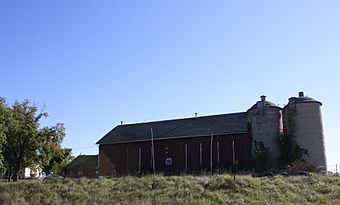Willard Greenfield Farmstead facts for kids
Quick facts for kids |
|
|
Willard Greenfield Farmstead
|
|

Willard Greenfield Farmstead
|
|
| Location | N-7436 WI Trunk Hwy. 26 Burnett, Wisconsin |
|---|---|
| Area | 5.2 acres (2.1 ha) |
| Built | 1862 |
| Architectural style | Greek Revival |
| NRHP reference No. | 92001557 |
| Added to NRHP | November 5, 1992 |
Welcome to the Willard Greenfield Farmstead! This historic farm, located in Burnett, Wisconsin, is like a time capsule. It shows us what farm life was like long ago. This special place tells the story of early settlers in Wisconsin.
Contents
Exploring the Historic Farmstead
The Willard Greenfield Farmstead is more than just a house. It's a collection of buildings that show how a farm operated over many years. The main house was built in 1862. Other buildings were added later, as the farm grew and changed.
The Main Farmhouse
The farmhouse was built in 1862 by Willard Greenfield himself. He was an immigrant from New York. Willard was one of the very first settlers in Dodge County, Wisconsin. The house is built in the Greek Revival style. This means it looks a bit like ancient Greek temples. It often has tall columns and a grand entrance.
Other Important Farm Buildings
Over the years, many other buildings were added to the farm. Each one had a special job.
- A fieldstone smokehouse was built in 1891. Farmers used it to preserve meat by smoking it.
- A large dairy barn was added in 1895. This is where cows were kept and milked.
- A machine shed from 1900 stored farm equipment.
- A poultry barn, built in 1920, housed chickens and other birds.
- A corn crib from 1920 was used to store corn. It had slatted sides for air to dry the corn.
- Two concrete silos were built in 1929 and 1930. Silos are tall towers used to store "silage," which is fermented feed for animals.
- A 2-hole privy (outhouse) was built in 1935. This was the farm's restroom before indoor plumbing.
A Place of History
The Willard Greenfield Farmstead is important because it shows how farms developed in Wisconsin. It also shows the daily life of families who settled the area. Because of its historical value, the farmstead was added to special lists.
What is the National Register of Historic Places?
The Willard Greenfield Farmstead was added to the State and the National Register of Historic Places in 1992. The National Register is the official list of places in the United States that are important to history. When a place is on this list, it means it's recognized for its historical, architectural, or archaeological significance. It helps protect these special places for future generations to learn from and enjoy.

